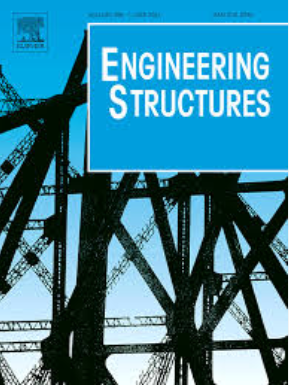A new impact factor considering structural morphology for concrete gravity dams subjected to underwater non-contact explosion
IF 6.4
1区 工程技术
Q1 ENGINEERING, CIVIL
引用次数: 0
Abstract
The impact factor has a promising prospect in the prediction and assessment of shock wave induced damage to structures under underwater explosion. However, the existing impact factors are not applicable to variable cross section structures because there is no consideration of the geometry effect of the target structure. In this paper, a new type of underwater explosion impact factor, which can comprehensively consider the effects of detonation position, interface reflection, and geometric properties of target structures, is proposed. To verify the effectiveness of the impact factor proposed in this paper, an explosion model test is carried out and the reliability of the numerical simulation method is verified by comparing the numerical simulation results with the test results; a concrete gravity dam was taken as the research object, the damage to the dam subjected to various underwater explosion attack conditions is obtained by numerical simulation; through the analysis of mathematical relationship between the impact factor and the damage range, the effectiveness of the proposed impact factor is discussed, and the damage predicted effect of four different impact factors is also compared. The research shows that the impact factor proposed in this paper can accurately predict the local damage of the concrete structure under underwater explosion, combined with the damage classification criterion, can quickly obtain the damage level of the structure to underwater explosion.
考虑结构形态的混凝土重力坝水下非接触爆炸新影响因子
冲击因子在水下爆炸作用下结构震波损伤的预测与评价中具有广阔的应用前景。然而,由于没有考虑目标结构的几何效应,现有的影响因子并不适用于变截面结构。本文提出了一种综合考虑爆轰位置、界面反射和目标结构几何特性影响的新型水下爆炸冲击因子。为了验证本文提出的冲击系数的有效性,进行了爆炸模型试验,通过数值模拟结果与试验结果的对比,验证了数值模拟方法的可靠性;以某混凝土重力坝为研究对象,通过数值模拟得到了大坝在各种水下爆炸攻击条件下的破坏情况;通过分析冲击因子与损伤范围之间的数学关系,讨论了所提出的冲击因子的有效性,并比较了四种不同冲击因子的损伤预测效果。研究表明,本文提出的影响因子能准确预测混凝土结构在水下爆炸作用下的局部损伤,结合损伤分类准则,可快速得出结构在水下爆炸作用下的损伤等级。
本文章由计算机程序翻译,如有差异,请以英文原文为准。
求助全文
约1分钟内获得全文
求助全文
来源期刊

Engineering Structures
工程技术-工程:土木
CiteScore
10.20
自引率
14.50%
发文量
1385
审稿时长
67 days
期刊介绍:
Engineering Structures provides a forum for a broad blend of scientific and technical papers to reflect the evolving needs of the structural engineering and structural mechanics communities. Particularly welcome are contributions dealing with applications of structural engineering and mechanics principles in all areas of technology. The journal aspires to a broad and integrated coverage of the effects of dynamic loadings and of the modelling techniques whereby the structural response to these loadings may be computed.
The scope of Engineering Structures encompasses, but is not restricted to, the following areas: infrastructure engineering; earthquake engineering; structure-fluid-soil interaction; wind engineering; fire engineering; blast engineering; structural reliability/stability; life assessment/integrity; structural health monitoring; multi-hazard engineering; structural dynamics; optimization; expert systems; experimental modelling; performance-based design; multiscale analysis; value engineering.
Topics of interest include: tall buildings; innovative structures; environmentally responsive structures; bridges; stadiums; commercial and public buildings; transmission towers; television and telecommunication masts; foldable structures; cooling towers; plates and shells; suspension structures; protective structures; smart structures; nuclear reactors; dams; pressure vessels; pipelines; tunnels.
Engineering Structures also publishes review articles, short communications and discussions, book reviews, and a diary on international events related to any aspect of structural engineering.
 求助内容:
求助内容: 应助结果提醒方式:
应助结果提醒方式:


